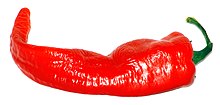Cayenne pepper
Cayenne pepper ([ kaˈjɛn ]) is a spice made from ground chilies . The dried, hot fruits of the chilli variety Cayenne serve as the basis for this ; but often spice powders from other cayenne-like varieties are sold under this name. Cayenne pepper is not, as one might infer from its name, obtained from the fruit of a pepper plant (Piperaceae). Characteristic are the slightly smoky, somewhat bitter taste and a pungent sharpness, which is specified as 30,000 to 50,000 Scoville units . This heat is caused by capsaicin with a content of less than one percent. Chili also contains a lot of vitamin C .
history
The spice has its origin in Latin America . Finds in prehistoric tombs in Ancón and Huaca Pieta in Peru show that as early as 7000 BC Cultivation attempts took place. The Spaniards who came to Latin America in the 15th century valued the dried pods as a substitute for black pepper. They called her pimienta and took her out to their homeland. The Portuguese also brought the plant to their homeland and their settlements on the east Indian islands. The plant was quickly known throughout southern Europe and from there spread to all major cities in Europe. In the 18th century, powdered cayenne pepper was particularly popular in England, which was used to flavor Indian dishes that had become famous from the colonies. Nowadays, cayenne pepper is also used in powdered form, v. a. with dishes from India, Indonesia, South America and China.
Medical application
The value-determining portion of the ingredients are the capsaicinoids - including capsaicin - which are responsible for the spiciness. The hot substances also stimulate the pain and heat receptors of the skin and mucous membranes and thereby cause increased blood flow. This effect is used for the external treatment of painful muscle tension in the shoulder-arm area and in the spinal column, for example in heat plasters .
In combination with kaolin (clay), water and mustard oil , cayenne pepper ( capsaicin is the active ingredient) is used in the form of Munari packs (Italian pack) as heat therapy for pain and tension in the musculoskeletal system, individually or in combination with massage .
Further application
Cayenne pepper is also a component of some pepper sprays .
See also
literature
- Michelle Berriedale-Johnson: The Little Bell Pepper Book. Droemer Knaur, pages 11-13
Individual evidence
- ↑ Capsicum (paprika) - areas of application . Monograph BGA / BfArM (Commission E). February 1, 1990. Issue 22A. ATC code M02AB. Retrieved July 21, 2014.
- ↑ Gerda Vacariu, Othmar Schuhfried, Marta Korpan: Physical therapy and rehabilitation for pain syndromes in the musculoskeletal system. In: Compendium of Physical Medicine and Rehabilitation. 3rd edition, 2013, p. 357, ISBN 978-3-7091-0467-5 .
